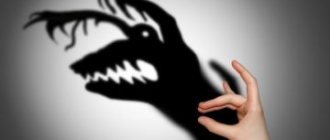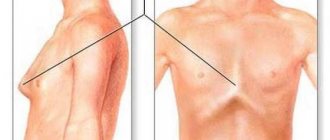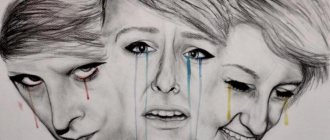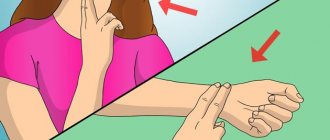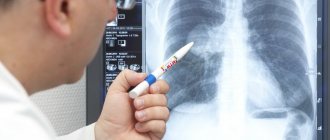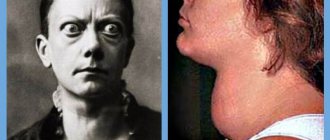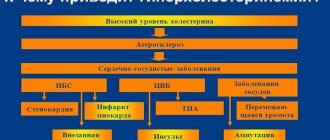.
In psychotherapy, the state of hysteria is called a destructive disorder that can develop into a severe form of neurosis. People often confuse hysterical seizures with other mental disorders. But they are easier to treat than any other disorder at an early stage, so if you experience such symptoms, it is better to see a doctor right away.
Causes of hysteria
Hysteria is a condition during which a person is unable to adequately behave and respond to external stimuli. This behavior is demonstrative, more often reminiscent of protest and a sharp reaction to some action of another person.
The main causes of hysteria:
- Features of human development. It happens that a child is raised in difficult conditions or is overly spoiled. Then, hearing his parents contradict his desire, he falls into a state of severe hysteria.
- Behavioral features. People with increased emotionality suffer from hysterical attacks. They do not know how to control their emotions, so it is easier for them to yell at someone than to adequately solve the problem.
- Physical overexertion. It happens that a person has overworked, is mentally and physically tired and wants to rest, but others are putting pressure on him. He sleeps little (3–4 hours a day), eats irregularly, eats unhealthy foods, and refuses to exercise. Then he may not be able to stand it, and there will be an outburst of negative emotions.
- Moral exhaustion. Hysteria can be the result of emotional burnout, nervous breakdown, or professional deformation. It often appears in women during PMS or menstrual periods, dieting or lack of self-esteem. The beginning may be a conflict, which soon develops into a serious scandal. Then a person really gives in to emotions and can start crying at one moment and be happy at another.
In addition, hysteria may be the initial stage of mental illness. This symptom often manifests itself in people with manic tendencies, panic attacks or vegetative-vascular neurosis.
Symptoms of hysteria in women
The symptoms of the disease manifest themselves clearly and clearly - the behavior of patients under stress is very different from how they behave on a daily basis. The most accurate definitions that are used to describe the actions of such people at the time of an attack are theatricality and expressiveness.
General signs
Hysterical psychosis, or hysteria, has the following symptoms:
- mood changes quickly and unpredictably;
- increased impressionability appears;
- A woman is characterized by defiant, sometimes deliberately shocking behavior;
- clothes, hairstyle and makeup become too prominent against the general background;
- sleep disturbances appear, manifested in the form of vivid dreams, and nightmares are possible.
Severe forms of the disorder
In severe forms of the disease, patients experience hysterical attacks; an attack may look like stiffness, immersion in a state of pathological fear, and the appearance of paralysis of the limbs. Some individuals with great self-hypnosis are characterized by disturbances in the functioning of the organs of vision, hearing, smell and taste, and loss of sensitivity of the skin.
Some patients suffer from seizures accompanied by hallucinations. For some, during an attack, they are characterized by immersion in a twilight state of consciousness, which is accompanied by mental disorders that are not characteristic of patients in everyday life.
Hysteria is severe and develops in patients from an early age. The nervous system, weakened by the disease, experiences psychological stress beyond its strength. As a result of this, the painful symptoms that arise take root in the behavior of patients and become a natural reaction of the sick to the world around them. As a result, many develop unbridled imagination and pathological deceit, and show signs of despotism in behavior.
Differences from an epileptic seizure
Hysterical seizures must be distinguished from epileptic seizures. For epileptic seizures, it is not necessary to have witnesses - they can overtake the patient even during sleep. The duration of the attack is short - up to 2 minutes; at this moment, patients can observe rhythmic contractions of the facial muscles, strong clenching of the thumbs in fists.
During an attack, acts of urination and defecation are possible, and there is a risk that the patient’s tongue will stick. After an attack, the victim feels drowsy and finds it difficult to return to his usual state.
Hysterical attacks are characterized by their theatricality and require witnesses. They continue for up to several hours. The movements of patients are designed to specifically harm themselves, or to create the impression that they want to harm themselves.
Severe seizures are characterized by a “hysterical arch,” when patients arch, resting only on the back of their head and heels. From this position, patients often move into acting out entire performances to demonstrate the horror, suffering or anger they experience.
Symptoms
Each person has their own characteristics of a hysterical attack, but there are common symptoms of this condition. The first significant sign is confusion. A person does not know what to do correctly at a particular moment and cannot adequately assess the situation and make a decision. Gradually, internal tension increases, and he begins to get very nervous. As a result, the following symptoms appear:
- increased sweating;
- low or high blood pressure;
- dizziness, lightheadedness;
- feeling of nausea;
- muscle weakness, which may be accompanied by cramps and trembling;
- inhibited reaction, etc.
The next stage of hysteria is bouts of convulsive crying, which can abruptly turn into laughter. Usually ends with loud screams, a request for help and strong crying. Sometimes a person in such a fit tries to somehow calm himself down by saying affirmations.
The last stage - a person cannot control himself, and every day begins with sobs. He sees no meaning in life, wants to fall asleep quickly and constantly gets into conflicts.
How does a hysterical seizure differ from an epileptic seizure?
It is necessary to understand that a hysterical attack and an epileptic attack are completely different diseases. A fit of hysteria is caused by pronounced emotional reactions, which, as a rule, occur in the presence of “spectators” - close people or strangers. Most often, a hysterical attack is provoked by fear, grief, or resentment. Unlike an epileptic attack, during a hysterical attack the patient does not cause severe damage to himself and does not lose consciousness. An attack of hysteria lasts about 20 minutes, sometimes several hours, and the duration of an epileptic seizure is, on average, two minutes. After a hysterical attack, patients do not experience drowsiness and a feeling of stupor, which is characteristic of an epileptic attack.
Features of hysteria in children
A child’s hysteria is the result of his disharmonious upbringing. It usually develops in families where parents constantly quarrel, humiliate their son or daughter, and use physical force against him. Then such behavior is a manifestation of hopelessness. The child does not know how to behave in order to correct the situation.
Another option is that the baby is the only child in a rich family. All the attention is on him, which he quickly gets used to. In the future, any refusal or prohibition causes resistance in him in the form of screams and hysterics. The child becomes demanding.
Another case is families where there are too many prohibitions and restrictions, when the child does not have the right to choose. He wants more freedom of action, which is why hysterical attacks occur.
Typical manifestations of hysteria in children:
- The presence of screaming or increasing crying. This is the initial stage.
- The child hits his head against the wall. Other options are rolling on the floor, jumping a lot and strongly, banging his feet on the floor, hitting his parents or other people around him.
- The baby begins to scratch and bite others. May cause harm to oneself.
- The appearance of seizures. This is the last stage. Usually manifests itself in the form of abnormal and severe bending of the body (“hysterical bridge”).
Is hysteria a diagnosis?
Is hysteria a diagnosis?
It was only in the 19th century that the French neurologist Jean-Martin Charcot was able to prove that hysteria was still a disease and urged others to take it seriously. One of these was Sigmund Freud, who considered hysteria to be a type of neurosis. He suggested that the whole problem lies in the sexual sphere. For example, if a girl experienced violence in childhood and the memories have become so unbearable that they are now expressed in hysteria. Freud believed that for such people it is like stimulating orgasm.
Even later, he concluded that hysteria may be associated with the Oedipus complex, when children are attracted to their parents. As a rule, girls outgrow the desire for sex with their father, identifying themselves with their mother.
In the situation with hysteria, Freud believed that the complex had not been overcome. Grown-up children no longer unconsciously want to be separated from their parents, and this leads to problems in their sex life. It is the suppression of sexuality that manifests itself in bodily symptoms or an overly violent emotional reaction. Not everyone is able to tolerate the Oedipal phase well, and therefore the majority retain historical features. That’s why the portrait is hysterical, everyone sees a little bit of themselves.
Consequences
During a hysteria, a person can be dangerous to others. He does not control his actions, acts impulsively and does everything on emotions.
If tantrums occur frequently, this may become the basis for the development of more serious mental illnesses.
The weakest among them is nervous breakdowns. This is the most common result of frequent hysterical attacks. Main symptoms:
- sudden mood changes several times a day;
- causeless tearfulness;
- prolonged apathy;
- long-term depression;
- excessive anxiety;
- increased fatigue;
- headache;
- sleep disorders (insomnia);
- poor appetite, etc.
Hysteria - symptoms and signs
There are many signs of this disease - for many centuries the cause was considered to be the “wandering” of the uterus in the woman’s body. The symptoms are still not clear, and recognizing the syndrome is not easy. The main signs of hysteria are considered to be:
- unhealthy, artificial behavior, playing in public;
- mood variability;
- need for attention, encouragement and approval from others;
- exploitation of other people's feelings and psychological parasitism;
- nosophilia (reluctance to recover);
- self-suggestibility and external suggestibility;
- lack of hobbies and interests, immaturity of personality.
The diagnosis is confirmed if three or more symptoms are observed. Although previously all abnormal over-emotional behavior was characterized as demonstrative hysteria. Screaming, laughter and tears, paralysis, deafness, convulsions, increased sexual activity - all these were signs of a developing disease. Only later did the diagnosis break down into types with great specificity: those identified by Freud, somatoform and personality disorders.
Hysteria in women - symptoms
The weaker sex is more emotional; suspicious individuals are especially susceptible to neuroses and mood swings. There is also such a diagnosis as hysteria before menstruation, when women become depressed and become whiny and irritable. But the disorder depends on the state of the body, and not on mental disorders. The female hysteria in question is a form of neurosis and manifests itself in unconscious behavior and the inability to control one’s thoughts and actions.
The main signs of hysteria are: self-centeredness, touchiness, desire to manipulate, suggestibility, superficial emotionality. Disorders can be observed throughout life. The duration of the attack depends on how much attention is paid to the patient. Hysterical personalities are dependent on the opinions of others and play to the public.
Hysteria in men - symptoms
Approximately the same symptoms and course of the disease are observed in representatives of the stronger sex. The patient tries to attract maximum attention to himself, but there is also a strong change in behavior. Actions in familiar situations are non-standard. Hysteria in men has the following interesting symptoms:
- frequent mood swings from laughing to crying;
- unsure gait “with unsteadiness”;
- complaints of lack of air and pain in the heart;
- headache;
- lack of sensation in some parts of the body.
Hysteria in children - symptoms
As a type of neurosis, childhood hysteria is a fairly common occurrence. It is observed in children of different ages, often accompanied by outbursts of anger and astasia-abasia syndrome, when the child refuses to walk and randomly moves his legs and arms. Seizures can result in convulsions, paralysis, auditory and visual impairment. Older children exhibit theatrical behavior. Young patients are very vulnerable, require increased attention, love to fantasize and lie. When surrounded by other people, a child may demonstrate unexpected and unnatural behavior.
Ways to quickly stop a tantrum
It is important to learn to recognize hysteria and be able to stop it yourself. The methods are universal and consist of the following:
- Don't persuade. Any persuasion or requests to calm down only aggravates the situation and irritates the patient. The actions of such a person are not always thought out; logic does not work.
- Leave the premises. This is especially true for situations with children. The presence of strangers makes you want to continue the hysteria. It is better to go outside, talk to the patient and give him time to come to his senses.
- Splashes of water. An excellent way to bring a person in a seizure to his senses. You need to splash a small amount of water on your face or pat your cheeks, lightly press on the painful point, etc. The main thing is to do this carefully and without much effort so as not to cause harm.
- Talk calmly. In this case, it is important not to blame the person for his bad behavior and negative character traits. It is necessary to explain that since such situations happen often, you should seek help from a doctor. It is important to do this without aggression or anger, but gently and calmly.
- Give me some water to drink. You can also give ammonia to smell.
If you need to stop hysterics in children aged 2–3 years, a method that will help is when the parent begins to talk to the child as if he were an adult. Explains to him why he cannot fulfill the request. Often parents say that this situation also depresses them and makes them sad, after which they present an alternative way to solve the problem. As a result, the child forgets about the offense and agrees to the proposal.
You can try to distract the baby. Ask to look out the window, show or draw something.
For children 3–5 years old, a sweet “pill” for hysterics is suitable. The point is, at the first sign of a breakdown, give the baby his favorite treat (it must be harmless, i.e. no chocolates, sweets or chips).
The easiest method is to simply hug the baby. To say that he is loved in any case, but with excessive whims he upsets his parents and makes them experience negative emotions.
What is hysteria and who are hysterics: concept
Who are the hysterics?
Try to say the word “hysteria” and you will definitely think of a crowd of fans cheering for their team’s next goal. But it’s better to try instead to remember if you know such a person who always strives to steal all the attention. He always tells events in detail so that everyone is interested. When talking with him, it becomes noticeable that other people are not interested in him, and his wardrobe is often provocative and extravagant.
His mood changes literally in minutes. One minute he's laughing, but the next minute he's crying. They say about such people - “hysterical” or “hysterical”. And if you call someone that, he will be very offended. But the word itself did not immediately enter the everyday lexicon and began to be used as a kind of insult. First of all, it was used in medicine.
Thus, frequent sudden mood swings, fainting, memory loss and paralysis were precisely called hysteria. Hippocrates believed that this condition manifests itself exclusively in women. This is due to the fact that with long-term sexual abstinence, the uterus gains mobility and “walks” around the body. This leads to compression of the organs and hence such unusual conditions arise.
But for many centuries, doctors were of the opinion that hysterics were simply malingerers. That is, hysteria was not recognized as a disease, and people simply pretended to be. And it’s true, all the symptoms appeared only when there were spectators and did not pose a danger. Even if a person pretends to faint, he falls softly. And this does not contradict the norms of behavior. For example, in the 18th century, if a person fainted in public, then he was considered a true aristocrat.
Treatment options
Ordinary hysteria cannot be cured. This is only temporary and demonstrative behavior, so you need to fight the reasons that cause it. Psychotherapy will help with this: cognitive behavioral therapy, art therapy, and medication.
Cognitive behavioral therapy
Its goal is to change a person’s behavior pattern, his type of thinking. During the healing process, people learn to understand their thoughts and analyze their actions. By the end of the course, the patient should become aware of his own condition and that it can and should be dealt with.
Cognitive behavioral therapy is done with a psychotherapist or psychiatrist. At the first session, he asks the patient leading questions:
- what provoked such behavior;
- why I couldn’t control my emotions;
- How often do such hysterical attacks of irritation and hatred and conflicts occur?
- the patient is enraged by specific people or their actions, actions, manners, etc.
At this and subsequent stages, client involvement is important. If he is not interested in treatment, you should not waste your time.
The course consists of 5–10 sessions depending on the specific situation. One consultation lasts 40–60 minutes. During the process, aspects of human behavior are discussed. It is possible to attend group classes.
Treatment consists not only of individual sessions, but also of homework. The goal of the latter is to work through their problems on their own. Understand the root causes of hysteria, learn to quickly recognize and prevent it. In this case, self-analysis is connected to cognitive behavioral therapy.
After each session, the adult patient is asked what he or she has learned about himself or his disorder. Often consultations take place in the form of role-playing games and active dialogue. This makes it possible to track progress and make a prediction whether the disorder will develop or this process may stop.
Art therapy
In psychology, this method of treatment is best for children from 3 to 10 years old. The idea is that with the help of some type of art you need to display your fears or hateful things. Allows you to understand why a child behaves in a certain way during a tantrum.
The colors that the child used in the drawing, all the lines and strokes, as well as ornaments are analyzed. The larger the size of the depicted object, the more clearly negative emotions appear.
After art therapy, you need to talk with your child. Ask to explain the drawing, what causes fear and provokes internal hysteria.
Art therapy will not cure hysteria. In psychiatry they believe that it only gives an idea of the nature of the problem, and psychoanalysis, hypnosis and cognitive behavioral therapy will help get rid of it. Suggestions and beliefs are used. The technique is chosen depending on the subject of hysteria.
Drug treatment
Sedatives are one of the fastest options to recover during a hysterical attack. They have a sedative effect. Herbal medicines will help:
- valerian;
- St. John's wort;
- chamomile;
- lavender;
- oak;
- motherwort;
- lemon balm;
- mint.
Sometimes the composition may contain B vitamins, which have a beneficial effect on the central nervous system.
For increased excitability, take bromine-based medications. If hysteria happens often - tranquilizers. They relieve emotional stress and eliminate anxiety. The best among them:
- "Buspirone";
- "Atarax";
- "Mezapam";
- "Mebicar";
- "Clozepid";
- "Amizil";
- "Phenazepam."
If the hysteria is so strong that it leads to insomnia, you need to take a sleeping pill. Sometimes chamomile or mint tea is enough.
Can men be hysterical?
Male hysteria
Of course, women are most often susceptible to hysteria. Although sometimes a similar condition occurs in men. According to psychoanalysts, hysteria irritates the female side and it only appears as pain in the abdomen, which indicates a desire to get pregnant. As a result, according to the Dictionary of Psychoanalysis, a man tries to gain a foothold in a woman’s camp and he shows his virility through seduction. In this way he expresses himself and appears in the eyes of others as an interesting and unusual person.
Such men are unapproachable Don Juans who must be begged to go on a date with a woman. And in general, if he condescended to be a beauty, then she should be grateful to him and rejoice even more if he agrees to spend the night with her. That is, he considers himself so unique that others are supposedly unworthy of him and the fact that he agreed to the meeting can be considered a favor. We must give him his due, despite this behavior, women still stick to him.
Prevention
There are several methods of prevention.
- Breathing techniques. You need to take 3 deep breaths in and out to calm down. The best technique is combined. It involves the collarbones, chest and abdomen. The inhalation begins from the stomach, passes through the chest and reaches the collarbones. Exhalation occurs in the reverse order. The interval between them is 3 s. 3-5 times are enough, no more is needed, otherwise you may feel dizzy.
- Affirmations. These are positive statements that work for self-hypnosis. Usually these are words like “calm down, everything will be fine, I can handle everything.” They help if a person has hysterical neurosis due to overload with work or moral exhaustion.
- Physical exercise. Running, race walking, boxing, dancing, gymnastics, aerobics - there is no difference. The main thing is that the person enjoys the activity. Yoga and meditation are also considered forms of physical activity. 2-3 classes a week are enough to get rid of accumulated negative energy and stop hysteria.
Prognosis and prevention
Hysterical neurosis in women can be easily cured if the disease is detected in a timely manner. However, if the psychological state of the patient’s personality is constantly influenced by external factors, such people require constant prevention of the disease and attention from loved ones.
Prevention of hysterical neurosis involves strengthening the nervous system, up to its preparation for natural overstrain. This is important for people whose work involves constant emotional stress, and children with a nervous system that has not yet fully formed.
It is important to limit people suffering from this disease from excessive expression of imagination. It is better to switch the attention of recovering patients to active but safe forms of recreation, such as sports. Women need to return to their familiar environment of life, where they have the opportunity to relax in a calm environment when the need arises. People living next to patients should not indulge their whims, nor should they be overly protective of them, otherwise patients will easily begin to manipulate their environment to achieve their goals.
An important aspect for healing sick women is proper nutrition, which contains all the vitamins and minerals necessary to strengthen the nervous system.
Women who have suffered hysterical attacks should be more attentive to their psychological health. Only independent monitoring of your own condition guarantees complete recovery from this disease.
Characteristics of conversion hysteria
Conversion hysteria has various symptoms. Her treatment takes place in the office of a psychoanalyst, who first of all identifies the severity of the manifestations.
First, there are the bodily symptoms. They are very changeable in nature and in this case they are connected not with disorders of an anatomical or physiological nature, but with mental phenomena.
Secondly, external emotional indifference. This is a very serious symptom.
Thirdly, episodic mental states - hysterical attacks. They can be either an independent expression or combined with the above symptoms. Seizures involve a split in certain mental functions.
Often such attacks are accompanied by female hysteria. Symptoms in women also include complex fantasy stories and dreams that can be analyzed. They are the result of distortions that arise due to the influence of defense mechanisms.
Conversion hysteria represents a number of striking bodily symptoms. Women experience motor, visceral or pain, deafness, tremors, blindness, paralysis, vomiting. But these symptoms are false. They do not confirm anatomical and physiological disorders. But hysterics are fully convinced that their symptom is serious and very real.
Hysterical symptoms arise when conflicts awaken, which took place during the period of human psychosexual development. Dangerous is the desire of the mother or father (depending on the sex of the child), which is subject to an incestuous ban. According to S. Freud, some types of hysteria also depend on pregenital conflicts, namely oral ones.
The essence of the disorder
People with hysterical disorder (hysterical disorder) look unusual, bright, theatrical. Their behavior and appearance are provocative and seductive. They are asking for compliments. They want to be the center of attention at any cost. They say about them “negative PR is also PR.” For inattention to their own person, hysterical individuals punish others with irritation, aggression and resentment.
At the same time, hysterical individuals suffer from unstable self-esteem. They strive to please and please everyone. They take all relationships too closely, and react to all events very emotionally. This makes them easily disappointed in people and suffer over little things.
Others see them as insincere. First of all, precisely because of the intensity of emotions and violent reactions to trivial things.
Hysterical individuals are characterized by repression. They choose from life and events what they like and benefit from, which will create drama. Very often important details are left out. In relationships, such omissions provoke conflicts.
Some scientific sources classify histrionic disorder as a borderline disorder. Indeed, in both cases, individuals are distinguished by emotional instability and a pronounced dependence of the individual’s state on the opinions and assessments of the environment. And also in both cases, the person is only capable of unstable and superficial relationships.
Causes
Neurosis is based on features of personality development, behavior, and so on. Of great importance in determining the causes of hysteria is personal dependence on the experience, be it positive, joyful events in life or negative.
Risk factors for hysteria:
- Physical overexertion;
- Trouble in family relationships;
- Dissatisfaction with one's social status;
- Alcohol abuse;
- Uncontrolled and not recommended use of sleeping pills and tranquilizers.
Prevention and traditional methods of treating hysteria
Prevention of the disease is carried out in the direction of a person’s positive emotional mood. You should create a friendly environment (this is especially true for children - they need to communicate with peers, play) and be in companies more often, travel, and have a good rest in order to escape from life’s problems. Also, there is no need to wait until there is an attack of hysteria. Most behave nervously, so using sedatives for prevention will not harm even healthy people.
Hawthorn tincture - a folk remedy for treating hysteria
The following plants are used as folk remedies for treatment: hawthorn, motherwort, lemon balm, valerian, capitol, St. John's wort, adonis, angelica, fireweed, viburnum, etc. All these plants have a calming effect on the body. Here are some recipes.
1 . If you do not want to take valerian tincture or tablets because they may contain chemical impurities or alcohol, you can prepare an infusion of valerian root at home. Take 1 tbsp. spoon of crushed valerian roots and throw into a glass of boiling water. Leave overnight, always in a thermos. Take 1 tbsp three times a day. spoon. If excessive excitability occurs, the dose can be increased. It is recommended to drink valerian for no more than 1 month, otherwise side effects may appear, including nausea, dizziness, and irritation of the gastrointestinal tract.
2. You can prepare an infusion of angelica officinalis (from roots and rhizomes). Pour 1 teaspoon of this raw material into a glass of boiling water. It is recommended to drink half a glass three times a day. You can also take soothing baths with angelica. For this you only need 1 liter of infusion.
3. Grind the dry fruits of blood-red hawthorn (take 2 tablespoons), pour in 1.5 cups of boiling water, and leave. Divide into three doses and drink half an hour before meals.
In addition to herbal treatment, various water procedures are used: baths, swimming and even water massage. Gymnastics, walks in nature and a positive psychological attitude are also useful. You need to repeat to yourself: “I’m calm, I won’t be nervous anymore, I’m healthy, I have no problems.”
Nowadays they use various modern techniques, in particular Chinese ones. They teach that specific points on the arms, legs and other parts of the body are responsible for our nervous excitement and other diseases. Warning: do not use these methods and folk remedies without a doctor’s permission.
Remember that you can get rid of hysteria if you want to. The patient’s desire to be healthy is of great importance in solving this problem. Try to make every effort to change yourself. Please note that because of your nervous behavior, first of all, it is difficult for your loved ones. By being subjected to hysterical aggression, you destroy everything around you, and first of all your relationships with your loved ones or family. Therefore, using complex therapy, you can calm your nerves. Do not delay time; if you notice that you are not calm, contact a specialist.
Neurosis (hysterical attack) in children, symptoms
Hysteria is a neurosis that is manifested by a variety of neuropsychic disorders of the function of internal organs, sensitivity and motor sphere, great suggestibility and self-hypnosis of patients, their desire to attract the attention of others by any means.
Symptoms of neurosis (hysterical attack)
Neurosis is characterized by hysterical seizures, usually occurring immediately after any mental or emotional trauma, which are demonstrative in nature: the symptoms of a historical seizure are significantly intensified if there are other people near the patient who can painfully perceive the attack of a child or teenager.
In this situation, the pained expression on the patient’s face and the demonstrativeness of his behavioral reactions clearly increase.
A hysterical attack or neurosis begins, as a rule, after the action of a stimulus, and is accompanied by a fall (usually harmless) in the form of a slow descent to the floor or to the ground. After a fall, the patient often experiences trembling, the face turns red (very rarely turns pale or blue), he rolls on the floor, hits with his hands and feet, can bend in an arc, bite his hands, scratch his face and other parts of the body, tear clothes, pull out hair, wring hands, scream, moan, scream and shout out different phrases.
During neurosis, spasms of individual muscle groups or isolated contraction of one muscle often occur. In this regard, some patients at the time of an attack experience a sensation of a “lump” in the throat due to spasm of the muscles of the larynx, which is accompanied by a feeling of lack of air.
On the same basis, disturbances in the act of swallowing, constipation, urinary retention, and complete or incomplete passing paralysis of skeletal muscles are possible.
An attack of neurosis is sometimes accompanied by impaired skin sensitivity, hysterical blindness, deafness, loss of taste and smell. Sensory disturbances during hysteria often affect exactly half of the patient’s body, sometimes individual limbs, the face or part of it. During severe, prolonged hysterical attacks, visual, olfactory and other hallucinations are often observed, and short-term loss of consciousness may occur.
At the end of the hysterical attack, the patient’s condition quickly improves and he calms down. Sleep immediately after an attack rarely occurs. With proper upbringing of a sick child or teenager in the family and school, he maintains a sufficient age level of mental and physical performance.
Emergency care for neurosis
1. If a hysterical attack occurs at home or on the street, measures must be taken to ensure that there are no strangers nearby, and that an atmosphere of nervousness, fear and panic is not created around.
An attack of neurosis will most likely be stopped if you sprinkle cold water on the patient’s face and neck, lightly pat the face with your palm (sharp slaps on the cheek are unacceptable, as is sometimes recommended), and give them a whiff of cotton wool soaked in vinegar or ammonia.
Parents and other adult family members should instill in a sick child confidence and the non-danger of his illness, in particular attacks, in every possible way to distract his attention from unpleasant thoughts and painful experiences caused by the disease.
2. When caring for children with hysteria, those around them should take care of strict adherence to the doctor’s prescriptions. It should be borne in mind that even minor traumatic effects can cause a hysterical attack. For such children, it is necessary to limit emotional stress - noisy games, watching television, etc.
It is important to take thoughtful measures to prevent conflictual relationships between a sick child or teenager with peers at school and with family members at home and other persons. However, the impossible request of a sick child and his unreasonable desire may lose significance as the cause of a hysterical attack if parents and other people close to the patient gently and firmly reject them with reference to specific and convincing arguments.
3. The patient’s parents are recommended to keep a special diary in which they should note the frequency of attacks of neurosis, their nature, causes, subsequent well-being and behavior of the child. The patient should not be led to an attack, and if one occurs, measures should be taken to ensure that the child does not receive the desired benefit from the attack, especially if the hysterical attack is openly demonstrative in nature.
Adults should always remember that they are not dealing with a malingerer, but with a sick person, towards whom there should be a respectful and sensitive attitude, but with the exception of ingratiation and servility. The mocking or irritable tone of parents and other adults in their relationships with a sick child or teenager is unacceptable, even when there is a clearly demonstrative hysterical attack.
Hysteria (neurosis) is a chronic disease and parents of a sick child usually have at home some medications that can prevent and stop a hysterical attack. These drugs, taking into account the prescriptions of the attending physician, should be used as needed, in particular to relieve this disease.
sovetcik.ru
Let's say no to hysteria
Prevention of a hysterical attack mainly consists in ensuring that all relatives who surround the patient show a normal attitude towards him.
This means that you should not be overprotective, because the patient may understand everything incorrectly, which will become the reason for another manifestation of a hysterical state. Walking in the fresh air and engaging in some calm and soothing activity will be helpful.
It is important to remember that a favorable and positive atmosphere must always be present in the family (quarrels and scandals can only aggravate the course of the disease).
Hysterical neurosis: treatment
All treatment of hysteria comes down to eliminating the source of internal conflict. Psychotherapy is a method that you cannot do without. The main techniques used in treatment are hypnosis, training, and suggestion.
During hypnosis, the doctor can use the method of free association, with which it is possible to identify a chain of associations that connect the primary pathogenic pattern with the symptom. This procedure can take a long time, since unraveling associative chains is not an easy task. The doctor finds out the patient’s character traits and the importance of certain motives. The psychoanalyst also overcomes the resistance of the patient who does not want to reproduce the traumatic events at all.
It is worth noting that such a direction as psychoanalysis does not provide for mechanical role playing. A person must take off all masks and appear as he is. Such sincerity concerns not only the patient, but also the doctor. The psychoanalyst has access to personality formation, and a lot in the patient’s life will depend on the doctor. Maximum dedication can also provoke a doctor, so each psychologist has his own psychologist.
The presented one became an in-depth continuation and development of Breuer's cathartic method. Hypnosis was replaced by communication rich in emotions and the moral influence of the doctor on the patient. The impulses that were released led to catharsis.
The above methods help the patient to realize that he is running away from the disease, and thus healing begins.
Drug treatment is also used. Patients are prescribed psychotropic drugs (Aminalon, Nootropil), Rudotel medication, darsonvalization of the legs and restorative drugs that support health and mental state. Taking vitamins and massage sessions have a positive effect on the entire body.
Hysterical attacks in children are treated with simpler methods. The most effective techniques are suggestion and false treatment. Having found out the reason, parents will help cure children's hysteria.
Folk remedies are also used to eliminate hysterical neurosis. There are various herbs that calm the nervous system (mint, valerian, motherwort).
Causes of the disorder
The roots of the disorder go back to childhood:
- Probably, the parents did not notice the child, were busy with work, and paid attention only when the child was ill. The feeling of uselessness and loneliness, unsatisfied desires and needs of the child are prerequisites for the development of hysterical disorder.
- Demanding parents who force the child to deserve love is another possible reason.
- Another unfavorable family upbringing style that can lead to hysterical disorder is “family idol” upbringing. Indulging in the whims of a child and elevating his personality to a cult is also not beneficial.
Female hysteria
The third type of this disorder is female hysteria. Symptoms in women have their origins in hormonal metabolic processes. In this regard, the disease is associated with the activity of the gonads, which produce steroids. These substances affect a woman’s mood during the menstrual period. Hormone surges during puberty and the postpartum period cause a disorder such as hysteria. A woman’s symptoms are characterized not only by the physiological side, but also by the behavioral side. Women strive to win everyone's attention, admiration, envy and surprise. They invent different stories and stories, dress provocatively. Their mood changes quickly. If the case is more severe, paralysis or paresis may occur, and then women need help in moving.
The patient's head may twitch without any reason. Speech is often impaired, stuttering, muteness, and hiccups appear. From the outside it seems that patients behave ridiculously.
Female hysterical attacks are characterized by sudden movements, screams, and screams. The patient pulls out her hair and cries. Such an attack can be stopped by a sharp sound, cotton, severe pain and cold water. Hysteria clouds consciousness a little, but the patient remembers all the events.
Diagnostics
To diagnose hysteria, as a rule, instrumental and laboratory tests are not required. During a personal examination by a neurologist, the patient himself can more clearly express the following symptoms:
- increased tendon reflexes;
- "spasms" in the throat;
- hysterical laughter;
- tremor of fingers.
Additional “symptoms” that appear precisely during an examination by a doctor clearly indicate hysterical personality disorder. Laboratory tests are taken only if other underlying diseases are suspected.
Despite the fact that hysteria has well-defined signs, before starting treatment, it is necessary to conduct a special examination. Some symptoms, such as paralysis and sore throat, may indicate other psychiatric disorders. Therefore, treatment of hysteria should begin only after examination by a specialist and an accurate diagnosis. Self-medication is unacceptable.
Manifestations
Female hysteria can manifest itself in two forms - a hysterical attack and hysterical behavior.
Hype
Among the peculiar manifestations of female hysteria, one can note one of its varieties, which has long been known in Russia as hysteria. It was expressed in the fact that the clique had an uncontrollable desire to scream in church at certain moments of the church service, and sometimes to fall into real hysterics. Clique is in very close connection with the belief in corruption and possession by various demons that was widespread at that time among the people. And indeed, many hysterical cliques had a subconscious idea or even a conscious thought that they were “spoiled”, that they were possessed by an unclean spirit against their own will and desire. This belief may not be recognized by the cliques and is stored in the unconscious area.
It is very likely that many cases of healing of patients under the influence of conspiracies and other things should be explained by the fact that these diseases were actually symptoms of hysterical neurosis. Analyzing the symptoms of other hysteria, one cannot help but notice that they always do not correspond to the picture of actual damage to a particular organ or organ system. In particular, with hysterical paralysis, paralysis of individual muscles is never observed, as is the case with neurological diseases, when one or another nerve center is affected or nerve conduction is disrupted. This circumstance sometimes allows us to say that hysterical neurosis is a rather mediocre plagiarist. The detected signs correspond to the patient’s idea of the disease and the views prevailing among the population, that is, popular opinions about mental and somatic illnesses.
Sometimes, however, it is difficult to identify such a discrepancy. In the history of psychiatry, there are known cases of false hysterical pregnancy, when the patient not only experienced a sharp increase in the volume of her abdomen and mammary glands, but also experienced such characteristic signs of the onset of labor that her relatives hastily took her to the maternity hospital, where only the true nature of her pregnancy was revealed. suffering. It is interesting that, as a rule, the disclosure is received with hostility by the patient and causes a violent reaction of protest, indicating her reluctance to acknowledge reality.
Simulation of central nervous system disorders
Often hysterical symptoms imitate various types of damage to the central nervous system, vascular spasms, infectious diseases, as well as angina pectoris, bronchial asthma, and myocardial infarction. Most often, the symptoms of female hysteria are various kinds of painful sensations in the abdomen, heart, chest, spine, which do not subside under the influence of painkillers. Less common are various difficulty breathing, decreased or complete loss of sensitivity. For example, legs, arms or just parts of a limb.
Motor disturbances in female hysteria can manifest themselves in paralysis, the inability to stand or walk, or, on the contrary, twitching of the upper or lower limbs, frequent winking of the eyelids, stereotypical and unusual contractions of the muscles of the neck, face, and limbs. Contractions of the laryngeal muscles during hysteria can lead to loss of a woman’s voice (the patient speaks only in a whisper), or complete loss of speech. The patient with hysteria, however, even in this case does not lose contact with others, for example, through writing.
There are also cases of hysterical deafness and blindness (in one or both eyes). Causes surprise. that a patient with hysteria, having lost the gift of speech, does not at all strive to overcome the disturbance that has arisen through an effort of will. The composure with which the patient sometimes treats her illness is also striking. She, apparently, is not at all burdened by the unexpected paralysis and does not show any anxiety that would be appropriate in this case. Just as often, these patients with female hysteria display a peculiar ambivalence towards the symptoms and signs of the disease. On the one hand, they turn to the doctor asking for help, but on the other hand, they do not strive for recovery and even violently protest when they learn that there is no serious illness.
"Conditional Pleasantness"
All these observations reveal one characteristic feature of female hysteria, which psychiatrists called “conditional pleasantness” or “desirability of a painful syndrome.”
Careful questioning of a patient suffering, for example, from a hysterical pseudo-infarction and therefore forced to leave work and not leave the house for months, may lead to the conclusion that she simply does not want to leave her child in the care of her mother-in-law, for whom for some reason she feels a feeling of acute hostility. The patient is completely unaware of this. At the same time, it is obvious that the means used are clearly disproportionate to the goal achieved. The patient’s behavior indicates that she has a special value system, which she subconsciously follows. Along with the primary benefit from the disease, for some patients, the fact that when they get sick, they surround themselves with great care and attention from loved ones is important. They tried to explain the amazing ability of a hysterical patient to transform his mental experiences into somatic ones on the basis of assumptions about the hypertrophy of a number of mental functions or their regression at a primitive level. According to some psychiatrists, hysterical symptoms are manifestations of phylogenetically old adaptations serving the purposes of instinctive self-defense. Sometimes hysterical neurosis can result in depression and suicide attempts.
Two types of hysteria
Z. Freud also distinguished two types in the phenomenon of hysteria. Both cases share the basic feature of the concept of “hysteria.” The disease arises as a result of the action of such a protective mechanism as repression of the unfolding internal conflict.
Conversion hysteria involves the patient attempting to cope with internal conflict by turning it into bodily expressions or dissociation. Hysteria of fear does not allow the human self to overcome fear due to the presence of obsessive and phobic mechanisms. Phobic neurosis is another name for this type of phenomenon, “hysteria.” The reasons for the renaming are quite clear.
Treatment
Histrionic personality disorder does not always require hospitalization. In most cases, treatment of hysteria can be successfully carried out at home, if there is a favorable atmosphere for this.
For hysterical neurosis, both drug treatment and occupational therapy are used. If the patient has symptoms such as paralysis, sore throat, convulsions, seizure-relieving drugs are prescribed. If the patient is too excitable, the doctor may prescribe the following medications:
- valerian;
- bromine;
- tranquilizers.
Along with such medications, drugs with a general strengthening spectrum of action are prescribed. In some cases, sleeping pills are prescribed.
In combination with drug treatment, occupational therapy is used for hysteria. This will help distract the patient from the symptoms and make him socially adapted. It is important that at this stage of treatment, others treat the sick person as equals, without focusing on his illness.
Hysteria can also be treated using traditional methods. In this case, it is herbal medicine. As prescribed by your doctor, you can use decoctions of the following herbs:
- valerian;
- motherwort.
Pine-salt baths and acupressure also help patients well. But it is worth taking into account that any treatment methods should be used only as prescribed by a neurologist.
Treatment of hysterical psychosis should be mandatory and only as prescribed by a doctor. Even if the symptoms disappear as a result of self-medication, a relapse of the disease can occur at any time.
First aid for a hysterical attack
A hysterical attack is considered an emergency, but not life-threatening, so an ambulance cannot be called for hysteria. On the other hand, hysteria can manifest itself with symptoms that will be interpreted by others as “bad heart” - a person begins to choke, clutching his chest. In addition, a hysterical attack may look like an attack of acute psychosis. If it is impossible to say unequivocally that this is hysteria, then an ambulance usually responds to such descriptions of the patient’s condition. The patient is usually prescribed tranquilizers, and in severe cases, antipsychotics are added to them.
If a seizure occurs at home, then the person can be helped in old, time-tested ways:
- splash cold water on your face;
- let it breathe with ammonia;
- provide the person with privacy.
In addition, any means of distraction are recommended:
- Loud sounds - you can drop a chair, clap your hands loudly, shout;
- Unexpected actions - among the advice there are such as, for example, climbing on the windowsill and thereby surprising the patient, giving him a so-called “Chinese mirror” - starting to repeat all his actions after the patient and making a face.
If there is an urgent need to communicate with a person who is in a state of hysteria, you should use short phrases in the imperative mood: “Sit down,” “Drink some water,” etc. A person is simply not able to perceive longer reasoning.
After the attack is over, there is usually a kind of “rollback” - loss of strength, drowsiness, lethargy. It is recommended to give the person a cup of sweet tea and put him to bed.
How to help yourself?
When a tantrum occurs, the best way out for the person who has “lost it” is to work through the situation. In other words, you should not push your hysteria inside and suppress your emotions. It’s better to throw them out and, figuratively speaking, “enjoy your hysteria.” That is, it is necessary to discharge completely.
It’s another matter if hysteria is close, but it’s not there yet. In this case, you need to switch to something, try to distract yourself. The rule here is this: the stronger the internal tension, the more powerful the method of distraction should be.
Back to contents
Reasons for violations
Like most mental pathologies, the causes of hysteria include two large factors: heredity and environmental influence. Experience working with people exhibiting hysterical symptoms speaks in favor of a greater influence of external factors.
So, we will consider hysteria a psychogenic disease that develops against the background of stress, chronic fatigue, somatic diseases and sometimes due to neurodenerative pathologies (Alzheimer, for example).
Risk factors are considered:
- constant physical stress;
- injuries that have a long-term impact on a person’s life;
- acute dissatisfaction in the world of work (coupled with depression);
- chronic distortions in the family system;
- consequences of alcohol abuse;
- uncontrolled use of psychotropic substances (tranquilizers/hypnotics).
First aid
To provide first aid in case of a hysterical attack, you must follow the following rules:
- you need to try to calm down all the people around you;
- after this, the patient will need to be moved to a quieter place;
- it is desirable that as few people as possible be nearby;
- if possible, give alcohol (ammonia) a sniff;
- You shouldn't stand too close to the person, but it is important to stay at a distance so that they can see you.
It is strictly prohibited to do the following:
- leaving a person during a hysterical attack;
- forcibly restrain the patient's arms, neck, legs and head;
- shout at the patient.

